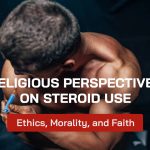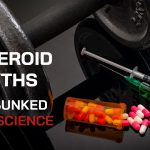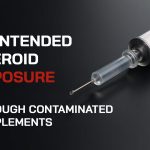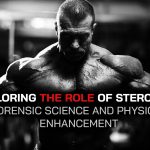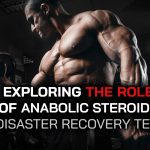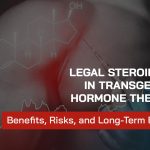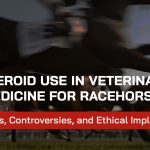Your basket is currently empty!
Category:
Steroid Use in Amateur Bodybuilding: A Comprehensive Guide to Risks, Benefits, and Considerations
November 16th, 2024 by anabolicpointAmateur bodybuilding, a sport that has grown in popularity over the past few decades, involves intense training regimens, strict diet control, and a desire to push the human body to its maximum potential. While many bodybuilders rely on traditional methods such as resistance training, nutrition, and recovery techniques to develop their physiques, others turn to anabolic steroids to accelerate muscle growth, strength gains, and recovery times. Steroid use in amateur bodybuilding is a topic that often sparks debate due to its potential for performance enhancement and the health risks it carries.
Steroid use in bodybuilding is not just confined to professionals or elite athletes. In fact, many amateur bodybuilders use steroids in an attempt to achieve faster results, boost their performance, and enhance their appearance. However, these substances come with significant risks that need to be carefully considered. In this article, we will explore the role of steroids in amateur bodybuilding, the benefits and dangers of steroid use, the types of steroids commonly used, and how it impacts the body in the long run.
Understanding Steroid Use in Amateur Bodybuilding
Anabolic steroids are synthetic derivatives of the male sex hormone testosterone, designed to mimic its anabolic (muscle-building) properties while minimizing its androgenic (masculinizing) effects. These steroids enhance the body’s ability to build muscle mass, increase strength, and promote fat loss by increasing protein synthesis and nitrogen retention in the muscles.
In bodybuilding, steroids are often used to amplify the effects of training, allowing athletes to push past plateaus and achieve greater results in less time. For amateur bodybuilders, this often translates into faster muscle gains, quicker recovery between workouts, and the ability to train harder and more frequently. However, steroid use is not without its risks, and understanding the long-term consequences is crucial for anyone considering using them.
Why Do Amateur Bodybuilders Use Steroids?
The decision to use anabolic steroids is often driven by a desire for quicker and more significant results in muscle growth, strength, and overall appearance. Some of the key reasons amateur bodybuilders may choose to use steroids include:
- Faster Muscle Gains: One of the primary reasons athletes turn to steroids is to accelerate the process of muscle hypertrophy. Steroids help increase protein synthesis, leading to more rapid muscle growth, particularly during intense training cycles.
- Increased Strength: Steroids can significantly boost strength by enhancing the body’s ability to produce and utilize energy, which helps bodybuilders lift heavier weights and improve their performance in the gym.
- Improved Recovery: Steroids can speed up recovery times by reducing muscle inflammation and increasing red blood cell production, which improves oxygen delivery to the muscles. This allows bodybuilders to train harder and more frequently, accelerating their progress.
- Fat Loss: Certain steroids promote fat burning while preserving muscle mass, making them attractive during cutting cycles. This allows bodybuilders to achieve a leaner, more defined physique.
- Psychological Boost: The use of anabolic steroids may also provide a psychological advantage, as the increase in testosterone levels can enhance mood, confidence, and aggression during training.
Despite these potential benefits, the use of anabolic steroids in amateur bodybuilding comes with serious consequences. These include health risks, legal implications, and ethical concerns that need to be carefully weighed before considering steroid use.
Types of Steroids Used in Amateur Bodybuilding
Amateur bodybuilders tend to use a variety of steroids depending on their goals—whether they are focusing on bulking, cutting, or overall performance enhancement. Some of the most commonly used anabolic steroids include:
- Testosterone (Cypionate, Enanthate, Propionate): As the most well-known and widely used anabolic steroid, testosterone is the base compound for many steroid cycles. It is highly effective for both bulking and cutting and helps promote muscle growth, strength, and fat loss.
- Dianabol (Methandrostenolone): Known for its rapid muscle-building properties, Dianabol is often used in bulking cycles. It promotes significant increases in strength and muscle mass, but it also carries a higher risk of side effects like water retention and liver toxicity.
- Deca-Durabolin (Nandrolone Decanoate): This steroid is popular for bulking and joint health due to its ability to increase muscle mass while reducing joint pain. It is often stacked with other steroids, such as testosterone, for enhanced results.
- Winstrol (Stanozolol): Used primarily during cutting phases, Winstrol helps athletes retain lean muscle while burning fat. It is commonly stacked with other steroids to enhance muscle hardness and definition.
- Trenbolone: A very potent steroid used by advanced bodybuilders for both bulking and cutting. It is known for increasing muscle mass, improving strength, and accelerating fat loss. However, it also comes with a range of serious side effects.
- Anavar (Oxandrolone): Anavar is considered one of the mildest steroids, making it popular among amateur bodybuilders looking for a steroid with fewer side effects. It helps build lean muscle and promotes fat loss, particularly in women and beginners.
- Masteron (Drostanolone): Masteron is often used in cutting cycles, helping bodybuilders achieve a defined and muscular physique. It is known for enhancing muscle hardness and reducing body fat.
Risks and Side Effects of Steroid Use in Amateur Bodybuilding
While steroids can deliver impressive results, the use of anabolic steroids comes with a range of potential risks and side effects. These can affect various aspects of health and well-being, including the cardiovascular system, liver function, hormonal balance, and mental health. Some of the most common risks associated with steroid use include:
- Cardiovascular Issues: Steroids can increase blood pressure, alter cholesterol levels, and strain the heart, leading to an increased risk of heart disease, stroke, and other cardiovascular problems.
- Liver Damage: Oral steroids, in particular, are known to be toxic to the liver. Prolonged use can lead to liver damage, liver cancer, or other serious liver conditions.
- Hormonal Imbalances: Anabolic steroids disrupt the body’s natural hormone production, which can lead to a decrease in testosterone production, resulting in side effects like erectile dysfunction, reduced libido, and mood swings. In men, it can also cause gynecomastia (development of breast tissue).
- Psychological Effects: Steroid use has been linked to mood swings, aggression, irritability, and even psychiatric disorders like depression and anxiety. The term “roid rage” is commonly used to describe the extreme aggression exhibited by some steroid users.
- Hair Loss and Acne: Steroids can exacerbate acne and cause hair thinning or male-pattern baldness, especially in those who are genetically predisposed.
- Testicular Atrophy: Prolonged steroid use can cause testicular shrinkage, as the body stops producing its own testosterone when synthetic testosterone is introduced.
- Kidney Damage: Some steroids, particularly when used in high doses or for long periods, can put excessive strain on the kidneys, potentially leading to kidney failure.
- Legal Issues: In many countries, anabolic steroids are classified as controlled substances, meaning that using them without a prescription is illegal. Athletes found using steroids in competition can face suspensions, fines, and loss of sponsorships.
Ethical Concerns in Amateur Bodybuilding
Beyond the physical risks, steroid use in amateur bodybuilding raises significant ethical questions. Many amateur bodybuilders face the dilemma of whether it is fair to use steroids in a sport where the goal is often to showcase personal dedication and hard work. Steroid use can create an uneven playing field, as some athletes may not have access to or choose not to use steroids, which can lead to feelings of unfair competition.
Moreover, using steroids without a prescription is illegal in many places, and using them in non-medical settings may be considered unethical by some. The use of performance-enhancing drugs (PEDs) also sends the wrong message to younger or aspiring athletes, encouraging them to prioritize shortcuts over healthy training practices.
The Role of Post-Cycle Therapy (PCT)
For amateur bodybuilders who choose to use anabolic steroids, Post-Cycle Therapy (PCT) is an essential part of the process. PCT involves a series of treatments used after a steroid cycle to help restore the body’s natural testosterone production, prevent the loss of muscle mass, and reduce side effects like gynecomastia.
Common PCT drugs include:
- Clomid (Clomiphene Citrate): A medication that stimulates the production of luteinizing hormone (LH), which helps boost natural testosterone production.
- Nolvadex (Tamoxifen): Often used to block estrogen receptors in the body to prevent the development of gynecomastia.
- HCG (Human Chorionic Gonadotropin): Stimulates the testes to produce testosterone naturally.
PCT is crucial to help mitigate the negative effects of steroid use and prevent long-term hormonal imbalances.
Frequently Asked Questions About Steroid Use in Amateur Bodybuilding
- Is it safe to use steroids in amateur bodybuilding? Steroid use carries significant risks, including liver damage, cardiovascular issues, and hormonal imbalances. It should only be considered after carefully weighing the benefits and risks.
- What are the most common steroids used by amateur bodybuilders? Common steroids include testosterone, Dianabol, Deca-Durabolin, Winstrol, Trenbolone, Anavar, and Masteron.
- How long does a steroid cycle last? A typical steroid cycle lasts between 8 and 12 weeks, followed by post-cycle therapy (PCT) to help restore natural hormone production.
- What is the purpose of stacking steroids? Stacking steroids combines different types of steroids to maximize muscle growth, fat loss, and strength. It is commonly done during bulking or cutting phases.
- How can I minimize side effects when using steroids? To minimize side effects, it is important to follow proper dosage guidelines, stack steroids wisely, and undergo PCT after a cycle.
- Are steroids legal to use in bodybuilding? In many countries, steroids are illegal to use without a prescription, and they are banned in most competitive sports organizations.
- What is Post-Cycle Therapy (PCT)? PCT is a treatment regimen used after a steroid cycle to restore the body’s natural hormone levels and prevent side effects like muscle loss and gynecomastia.
- Can I build muscle naturally without steroids? Yes, with proper training, nutrition, and recovery, it is possible to build muscle naturally without the use of steroids.
- What are the risks of using steroids in bodybuilding? Steroid use carries risks like liver damage, cardiovascular disease, hormonal imbalances, psychological effects, and legal issues.
- Can women use steroids in bodybuilding? Yes, women can use steroids, but they need to be cautious as steroids may cause virilization (masculine traits) like facial hair growth and deepening of the voice.
Final Insights on Steroid Use in Amateur Bodybuilding
Steroid use in amateur bodybuilding is a controversial topic that involves a delicate balance between achieving fast results and managing the long-term health risks. For those considering the use of anabolic steroids, it is important to make informed decisions and understand both the benefits and dangers. Ethical considerations and legal implications should also play a role in the decision-making process. Ultimately, achieving long-term success in bodybuilding requires not only hard work, discipline, and proper nutrition, but also a commitment to health and well-being.
The Effects of Steroids on Muscle Symmetry: An In-Depth Exploration
November 16th, 2024 by anabolicpointMuscle symmetry is a cornerstone of aesthetics in bodybuilding and fitness. It refers to the balance and proportional development of muscle groups, creating a visually harmonious physique. Achieving symmetry involves rigorous training, a keen understanding of anatomy, and dedication to tailored nutrition. However, the use of anabolic steroids—often touted for their ability to rapidly enhance muscle growth—complicates this picture.
Steroids play a significant role in the development of muscle mass, but their effects on symmetry are nuanced and multifaceted. This article explores the science behind steroid use, its impact on muscle symmetry, and the associated challenges and risks. By delving into the interplay between enhanced muscle growth and proportionality, we aim to provide a comprehensive perspective on this subject.
Understanding Muscle Symmetry and Its Importance
Muscle symmetry involves developing all muscle groups proportionally to achieve an aesthetically balanced physique. In bodybuilding, judges assess symmetry alongside muscle mass, definition, and presentation. Symmetry is not only a visual benchmark but also an indicator of functional strength and mobility.
For natural athletes, symmetry is achieved through consistent, targeted training and disciplined nutrition. In the context of steroid use, however, the rapid acceleration of muscle growth can sometimes disrupt this balance.
How Steroids Affect Muscle Growth
Anabolic steroids are synthetic derivatives of testosterone that amplify muscle growth by enhancing protein synthesis, nitrogen retention, and recovery. They work by binding to androgen receptors in muscle cells, initiating cellular processes that lead to hypertrophy (muscle growth). While this process can result in dramatic size increases, the effects are not always uniform across muscle groups.
Key factors influencing how steroids impact muscle growth and symmetry include:
- Genetic Predispositions: Genetics play a crucial role in determining muscle shape, insertion points, and response to steroids. Individuals with genetically dominant muscle groups may see disproportionate growth in those areas.
- Training Focus: Steroids amplify the results of training. Uneven training routines can exacerbate imbalances, as muscles receiving more focus will grow faster than neglected ones.
- Site-Specific Steroid Use: Some users administer steroids via localized injections, hoping to enhance specific muscle groups. This practice, while potentially improving size in targeted areas, often results in unnatural or disproportionate appearances.
- Recovery and Overcompensation: Steroids enhance recovery, allowing for more frequent training. However, overtraining or favoring certain muscle groups can skew symmetry.
The Role of Steroids in Muscle Imbalances
Steroids are not inherently disruptive to muscle symmetry, but their misuse or over-reliance often leads to imbalances. The rapid muscle growth facilitated by steroids can outpace the connective tissue’s ability to adapt, leading to uneven development or injuries that further exacerbate asymmetry.
Some common symmetry-related issues linked to steroid use include:
- Overdeveloped Dominant Sides: Right-handed or left-handed individuals often unconsciously favor one side during training. Steroids can amplify this imbalance, making it more noticeable.
- Uneven Chest or Shoulder Growth: Genetics and training patterns combined with steroid use can result in lopsided development of the chest or shoulders.
- Leg and Upper Body Disparities: Many users focus heavily on upper-body training, neglecting legs. Steroids enhance upper-body growth, accentuating this imbalance.
Psychological Impacts of Asymmetry and Steroid Use
The pursuit of symmetry is not just physical but deeply psychological. Many steroid users enter the world of performance enhancement seeking perfection. However, the realization of new imbalances or disproportionate growth can lead to frustration, body dysmorphia, and compulsive training behaviors.
For competitive athletes, noticeable asymmetry can be a source of anxiety, as it detracts from their overall presentation and score. This psychological burden can push some users toward more extreme or dangerous practices, including excessive steroid use or surgical interventions.
Muscle Symmetry and Competitive Bodybuilding
In competitive bodybuilding, muscle symmetry is a critical criterion. Competitors are judged on the even development of their left and right sides and the proportionality between muscle groups such as the arms, legs, chest, and back. Steroid use, while widespread in some divisions, presents both opportunities and challenges for achieving symmetry.
Some competitors use steroids strategically, pairing them with rigorous training regimens designed to address weak points. However, the risk of disproportionate growth or side effects that detract from symmetry—such as gynecomastia or abdominal distension—can undermine their efforts.
Long-Term Effects of Steroids on Symmetry
The long-term use of steroids can have profound effects on symmetry. Over time, chronic imbalances may develop due to injuries, tendon strain, or uneven muscle growth. Additionally, cessation of steroid use often leads to muscle loss, and weaker muscle groups may lose mass at a faster rate, further skewing symmetry.
Aging athletes who relied on steroids may also experience disproportionate muscle atrophy, as the structural imbalances created during their peak years manifest more noticeably with age.
Mitigating the Impact of Steroids on Symmetry
For those who choose to use steroids, maintaining symmetry requires careful planning and discipline:
- Balanced Training Programs: A focus on even training intensity and volume across all muscle groups is essential.
- Regular Assessments: Periodic evaluations of muscle symmetry through photos or professional assessments can identify developing imbalances.
- Injury Prevention: Avoiding overtraining and addressing minor injuries promptly reduces the risk of long-term imbalances.
- Consulting Experts: Working with coaches and medical professionals can help users manage steroid regimens responsibly and prioritize symmetry.
Ethical and Health Considerations
Steroid use raises significant ethical and health concerns, particularly in competitive sports. While some users argue that steroids are a personal choice, the potential for harm—both to the individual and to the integrity of sports—cannot be ignored. For those considering steroids, the pursuit of symmetry should never come at the cost of long-term health.
Questions and Answers About Steroids and Muscle Symmetry
- Can steroids improve muscle symmetry?
Steroids can enhance muscle growth, but symmetry depends on balanced training and genetics. Without careful management, steroids may worsen imbalances. - Why do steroids sometimes cause muscle asymmetry?
Rapid muscle growth, uneven training, and genetic predispositions can lead to disproportionate development. - Is localized steroid injection effective for symmetry?
While localized injections may increase size in specific areas, they often result in unnatural appearances and carry additional risks. - Do steroids affect tendons and ligaments?
Steroids can strengthen muscles faster than connective tissues, increasing the risk of injuries that contribute to asymmetry. - Can natural athletes achieve better symmetry than steroid users?
Natural athletes often have better long-term symmetry because their muscle growth occurs more gradually and proportionally. - How do genetics influence symmetry with steroid use?
Genetics determine muscle shape and insertion points. Steroids amplify genetic strengths and weaknesses, potentially affecting symmetry. - Can injuries from steroid use cause lasting asymmetry?
Yes, injuries such as tendon tears or muscle strains can lead to chronic imbalances. - What happens to symmetry after stopping steroids?
Muscle loss occurs after cessation, and weaker or smaller muscle groups may lose mass faster, further disrupting symmetry. - Are there alternatives to steroids for improving weak areas?
Yes, targeted training, nutrition, and legal supplements can enhance weaker muscle groups without the risks of steroids. - How can one prevent asymmetry while using steroids?
Balanced training, regular assessments, injury prevention, and consulting professionals are key to maintaining symmetry.
Embracing Proportional Growth: A Path Forward
The effects of steroids on muscle symmetry are as complex as they are profound. While steroids can enhance muscle size and strength, achieving true symmetry requires more than pharmacological intervention. It demands balanced training, a deep understanding of one’s body, and a commitment to long-term health.
For those pursuing extreme physiques, the allure of rapid growth must be tempered by the risks and challenges of maintaining balance. Whether through natural methods or with the aid of steroids, the ultimate goal should always be a harmonious, functional, and healthy physique.
Popular Bodybuilding Steroid Stacks: Unlocking Performance Gains and Maximizing Results
November 16th, 2024 by anabolicpointBodybuilding, as a sport, demands relentless dedication, discipline, and hard work. Achieving a physique that stands out in the competitive world of bodybuilding often requires pushing the body to its limits, and for some athletes, anabolic steroids provide a significant boost in achieving their goals. While many bodybuilders rely on strength training, proper diet, and recovery methods to see progress, steroid stacks have gained popularity for their ability to enhance muscle growth, increase strength, and promote fat loss.
Steroid stacking refers to the practice of combining different types of anabolic steroids to optimize results. The idea is that the synergistic effects of these compounds can work together to maximize muscle growth, strength, and recovery while minimizing the side effects that may arise from using a single steroid. This article will dive into the most popular bodybuilding steroid stacks, explaining how they work, the benefits, the potential risks, and everything you need to know before considering steroid use in your training routine.
Understanding Steroid Stacks in Bodybuilding
Steroid stacking is a common practice among bodybuilders looking to amplify their results. A “stack” typically refers to the combination of two or more different anabolic steroids taken together during a cycle. The idea behind this is that different steroids have different properties and work through various mechanisms in the body, allowing for enhanced muscle development and quicker recovery when used in combination.
While stacking anabolic steroids, athletes aim to take advantage of the “synergistic effect” — the theory that combining different steroids can yield better results than using a single steroid alone. For example, some steroids are better for bulking (increasing muscle mass), while others are better for cutting (fat loss and muscle definition), so stacking them can provide a more balanced approach to achieving different physique goals.
Anabolic steroids used in bodybuilding are synthetic derivatives of testosterone, designed to mimic the hormone’s anabolic properties of muscle growth while minimizing its androgenic (masculinizing) effects. When stacked, they can significantly improve muscle mass, strength, endurance, and fat loss.
Why Do Bodybuilders Use Steroid Stacks?
Bodybuilders typically use steroid stacks to:
- Maximize Muscle Growth: Stacking different steroids that promote muscle hypertrophy can lead to rapid increases in muscle size and strength.
- Enhance Fat Loss: Some steroids help reduce fat while preserving lean muscle mass, making them ideal for cutting cycles.
- Improve Recovery Time: Steroids help speed up muscle recovery, allowing athletes to train harder and more frequently.
- Increase Strength: Certain steroids have been shown to significantly boost strength, which can enhance performance in training and competitions.
- Minimize Side Effects: Some steroid stacks are designed to balance the effects of individual steroids, reducing the risk of side effects.
Popular Steroid Stacks in Bodybuilding
While there are a variety of steroid stacks that can be used in bodybuilding, some combinations have gained a reputation for being particularly effective. Here are some of the most popular steroid stacks used by athletes today.
1. Testosterone and Deca-Durabolin Stack
The combination of testosterone (often used as the base steroid) and Deca-Durabolin (nandrolone) is one of the most popular steroid stacks for bulking cycles. Testosterone provides the body with the anabolic effects necessary for muscle growth, while Deca-Durabolin supports collagen synthesis, which helps with joint health and muscle recovery. This stack is ideal for athletes looking to increase muscle mass and strength while reducing joint pain.
- Testosterone: Increases muscle mass, strength, and red blood cell production.
- Deca-Durabolin: Promotes muscle growth and helps with recovery by improving joint health.
2. Trenbolone and Testosterone Stack
Trenbolone is one of the most powerful anabolic steroids used in bodybuilding. When stacked with testosterone, it creates a potent combination for both bulking and cutting. Trenbolone increases protein synthesis, nitrogen retention, and red blood cell production, which helps athletes gain muscle mass quickly. It also promotes fat loss by increasing metabolism. When combined with testosterone, it enhances the overall effects of muscle growth and strength.
- Trenbolone: Increases muscle mass, boosts strength, and accelerates fat loss.
- Testosterone: Balances out the effects of trenbolone and supports overall muscle growth.
3. Dianabol and Deca-Durabolin Stack
For those focused on significant mass gains during the bulking phase, the combination of Dianabol (methandrostenolone) and Deca-Durabolin is a classic choice. Dianabol is known for its ability to rapidly increase muscle mass, strength, and endurance, while Deca-Durabolin helps with long-term muscle development and recovery. This combination is particularly effective at promoting quick and sustainable gains during a bulking cycle.
- Dianabol: Rapid muscle growth, increased strength, and endurance.
- Deca-Durabolin: Long-term muscle development, joint health, and recovery.
4. Winstrol and Anavar Stack
For bodybuilders aiming to cut fat while maintaining lean muscle mass, the combination of Winstrol (stanozolol) and Anavar (oxandrolone) is highly effective. Winstrol is known for its ability to enhance muscle hardness and definition while promoting fat loss, while Anavar provides mild yet effective muscle-building and fat-burning properties. Together, they help athletes achieve a lean, shredded physique without losing strength or muscle mass.
- Winstrol: Fat loss, muscle hardness, and definition.
- Anavar: Mild muscle gain, fat-burning properties, and improved endurance.
5. Anadrol and Testosterone Stack
Anadrol (oxymetholone) is a powerful steroid used for gaining muscle mass and strength. When combined with testosterone, this stack promotes rapid growth and increases red blood cell production, which enhances oxygen delivery to muscles. This can result in better endurance and quicker recovery times between sets, making it ideal for those in a bulking phase.
- Anadrol: Rapid muscle growth, strength, and endurance.
- Testosterone: Supports overall muscle development and balances out the side effects of Anadrol.
6. Masteron and Trenbolone Stack
Masteron (drostanolone) is a popular steroid for cutting cycles. When stacked with Trenbolone, a highly anabolic and fat-burning steroid, it can provide bodybuilders with a shredded, low-fat physique. This combination is ideal for athletes looking to preserve muscle mass while shedding body fat in preparation for competitions.
- Masteron: Muscle preservation and fat loss.
- Trenbolone: Fat loss, muscle gain, and increased strength.
7. Primobolan and Testosterone Stack
Primobolan (methenolone) is a mild anabolic steroid that is often used in cutting cycles or by those who want to preserve lean muscle during a calorie deficit. When combined with testosterone, it creates a balanced cycle that promotes lean muscle retention while helping to burn fat. This stack is effective for maintaining muscle mass during fat loss without the risk of significant muscle wasting.
- Primobolan: Lean muscle retention and fat loss.
- Testosterone: Overall muscle growth, recovery, and strength.
Benefits of Steroid Stacking for Bodybuilders
While steroid use can have significant benefits in terms of muscle growth, recovery, and fat loss, stacking provides the added advantage of maximizing the results that an athlete can achieve. Some of the primary benefits of steroid stacking include:
- Enhanced Muscle Mass: The combined effects of different anabolic steroids can promote faster and more significant muscle gains compared to using one steroid alone.
- Improved Recovery: Stacking steroids that enhance protein synthesis and reduce muscle damage can help bodybuilders recover faster, allowing them to train harder and more frequently.
- Increased Strength: Many steroids used in stacks help improve overall strength, which can result in better performance during workouts and competitions.
- Reduced Side Effects: By carefully selecting and balancing different steroids, athletes can minimize the side effects associated with high dosages of a single steroid.
- Fat Loss and Muscle Definition: Certain steroid combinations, such as those used in cutting stacks, can help athletes reduce body fat while preserving lean muscle mass, leading to a more defined and ripped physique.
Risks and Side Effects of Steroid Stacking
While steroid stacking can offer numerous benefits, it is important to recognize the potential risks and side effects. Some of the most common side effects of anabolic steroid use, especially when stacked, include:
- Hormonal Imbalances: Steroids can suppress the body’s natural testosterone production, leading to a variety of issues, including reduced libido, erectile dysfunction, and mood swings.
- Liver Toxicity: Some oral steroids, especially when taken in large doses, can be harsh on the liver, potentially causing liver damage or toxicity.
- Cardiovascular Risks: Steroids can increase the risk of high blood pressure, heart disease, and stroke, particularly when used for prolonged periods.
- Psychological Effects: Steroid use has been associated with mood swings, aggression (often referred to as “roid rage”), and even anxiety or depression.
- Side Effects on the Skin: Steroids can cause acne, oily skin, and hair loss, particularly in those predisposed to male-pattern baldness.
Frequently Asked Questions About Steroid Stacks
- What is the best steroid stack for beginners? For beginners, a simple testosterone-based stack with Deca-Durabolin or Anavar is a good starting point to promote muscle growth and strength while minimizing side effects.
- How do steroid stacks enhance muscle growth? Steroid stacks combine different anabolic steroids that work through various mechanisms, enhancing protein synthesis, nitrogen retention, and red blood cell production to maximize muscle growth.
- Are steroid stacks safe? While steroid stacks can offer significant gains, they carry substantial risks, including hormonal imbalances, liver damage, cardiovascular issues, and psychological effects.
- Can steroid stacks be used for cutting? Yes, there are steroid stacks specifically designed for cutting, such as Winstrol and Anavar, which help preserve lean muscle mass while promoting fat loss.
- How long should a steroid cycle last? A steroid cycle typically lasts between 8 to 12 weeks, followed by post-cycle therapy (PCT) to restore natural hormone production and minimize side effects.
- Are there any natural alternatives to steroid stacks? While no natural alternative can match the potency of anabolic steroids, supplements like creatine, protein powders, and branched-chain amino acids (BCAAs) can help support muscle growth and recovery.
- What are the most common side effects of steroid stacking? Common side effects of steroid stacking include hormonal imbalances, liver toxicity, cardiovascular risks, and psychological effects like mood swings and aggression.
- How can I minimize side effects when stacking steroids? To minimize side effects, it’s important to use proper dosages, stack well-researched compounds, and consider post-cycle therapy (PCT) to restore natural hormone levels.
- What is the difference between a bulking stack and a cutting stack? A bulking stack typically includes steroids like Dianabol or Deca-Durabolin to promote muscle mass and strength, while a cutting stack includes compounds like Winstrol or Anavar to reduce fat while maintaining lean muscle.
- Is steroid stacking legal? Steroid use without a prescription is illegal in many countries, and they are banned by most professional sports organizations. Athletes caught using steroids may face penalties or suspensions.
Final Thoughts: Considerations Before Using Steroid Stacks
While steroid stacking can offer significant benefits in terms of muscle growth, fat loss, and strength, it’s important to approach this practice with caution. The risks associated with steroid use — including health complications, psychological side effects, and legal consequences — should not be taken lightly. Before considering a steroid stack, it’s essential to weigh the benefits against the potential risks and consult a healthcare professional. Bodybuilders looking to improve their physique should always prioritize safe, sustainable methods such as proper nutrition, training, and recovery techniques.
The Role of Steroids in Achieving Extreme Physiques: Myths, Realities, and Risks
November 16th, 2024 by anabolicpointThe pursuit of extreme physiques—whether for competitive bodybuilding, athletics, or aesthetic appeal—has always drawn significant interest. While diet, rigorous training, and genetics play a substantial role, the use of anabolic steroids has become an undeniable part of the conversation. Steroids are often associated with rapid muscle growth, improved strength, and reduced recovery times. However, their use remains a polarizing topic, laden with controversy, ethical concerns, and health risks.
This article explores the intricate relationship between steroids and extreme physique enhancement, shedding light on the science behind them, the cultural fascination, and the potential dangers. We also delve into frequently asked questions to provide a comprehensive understanding of this complex subject.
Understanding Steroids: What Are They?
Anabolic steroids are synthetic derivatives of testosterone, the primary male hormone responsible for muscle growth, bone density, and male sexual characteristics. These substances mimic the effects of testosterone in the body, stimulating muscle tissue to grow by enhancing protein synthesis and nitrogen retention.
There are two primary categories of steroids relevant to physique enhancement:
- Anabolic-androgenic steroids (AAS): These are the most common steroids used to increase muscle mass and strength. Examples include Dianabol, Trenbolone, and Deca-Durabolin.
- Corticosteroids: These are primarily used to reduce inflammation and are not directly linked to muscle building.
While AAS are commonly associated with bodybuilding, their use extends to athletes in various sports, despite the ethical and legal implications.
How Do Steroids Enhance Extreme Physiques?
Steroids work by binding to androgen receptors in muscle cells, stimulating processes that promote muscle growth and strength. Key effects include:
- Enhanced Protein Synthesis: Steroids accelerate the body’s ability to produce proteins, the building blocks of muscle tissue. This leads to faster recovery and increased muscle size after intense workouts.
- Improved Nitrogen Retention: Maintaining a positive nitrogen balance is crucial for muscle growth. Steroids help the body retain more nitrogen, creating an anabolic environment conducive to muscle development.
- Reduced Muscle Breakdown: Steroids decrease the rate of catabolism, or muscle breakdown, allowing users to preserve muscle mass during intense training or calorie deficits.
- Increased Red Blood Cell Production: This boosts oxygen delivery to muscles, enhancing endurance and recovery.
- Fat Redistribution: Some steroids promote fat loss while building muscle, contributing to the lean, defined appearance desired by many.
The Cultural Obsession with Extreme Physiques
The fascination with sculpted bodies dates back to ancient Greece, where statues of gods and athletes epitomized physical perfection. In modern times, this ideal has been magnified by media, sports, and fitness influencers.
Bodybuilding competitions, such as Mr. Olympia, showcase physiques that often defy natural limits. While some achieve remarkable results through dedication and natural training, the prevalence of steroid use in these realms has blurred the lines between natural and enhanced physiques.
The pressure to meet these unrealistic standards can lead individuals to consider steroids, often without fully understanding the potential consequences.
The Risks and Side Effects of Steroid Use
The use of anabolic steroids is not without significant risks. These substances alter hormonal balances and can lead to a host of physical, psychological, and social issues:
- Physical Health Risks:
- Cardiovascular Issues: Steroid use is linked to increased LDL (“bad”) cholesterol, reduced HDL (“good”) cholesterol, high blood pressure, and heart disease.
- Liver Damage: Oral steroids, in particular, can strain the liver and cause long-term damage.
- Hormonal Imbalances: Suppressing natural testosterone production can lead to gynecomastia (male breast development), testicular shrinkage, and infertility.
- Skin Problems: Acne, oily skin, and hair loss are common side effects.
- Musculoskeletal Issues: While steroids enhance muscle strength, they do not strengthen tendons and ligaments, increasing the risk of injuries.
- Psychological Risks:
- Mood Swings: Steroid use can lead to irritability, aggression (often referred to as “roid rage”), and depression.
- Addiction: The psychological reliance on steroids for maintaining physique or performance can lead to dependency.
- Social and Ethical Issues:
- Stigmatization: Steroid users may face judgment or rejection from peers and society.
- Fairness in Sports: The use of steroids is considered unethical in competitive sports, with strict anti-doping regulations in place.
Legal and Ethical Considerations
In many countries, anabolic steroids are classified as controlled substances, making their non-medical use illegal. However, black-market availability remains prevalent. Athletes caught using steroids often face suspensions, fines, and damage to their reputations.
The ethical debate extends beyond legality. Should individuals have the right to use steroids to enhance their bodies? Or do such practices undermine the spirit of fair competition and natural achievement? These questions continue to fuel heated discussions within the fitness and sports communities.
Steroids vs. Natural Training: A Comparative Perspective
For those considering steroids, understanding the differences between natural and enhanced training is crucial:
- Muscle Growth: Steroid users experience faster and more substantial muscle gains. Natural trainees rely on consistent effort and time to achieve results.
- Recovery: Enhanced recovery with steroids allows for more frequent and intense training sessions. Natural lifters must carefully manage rest to avoid overtraining.
- Longevity: Natural training supports long-term health and fitness. Steroid use often comes with health trade-offs that can shorten athletic careers and affect overall well-being.
While the allure of rapid results may be tempting, the sustainable benefits of natural training often outweigh the short-term advantages of steroids.
Alternatives to Steroid Use
For those seeking extreme physiques without the risks of steroids, several alternatives exist:
- Optimized Nutrition: A diet rich in protein, complex carbohydrates, healthy fats, and micronutrients supports muscle growth and recovery.
- Progressive Overload: Gradually increasing the intensity of workouts ensures consistent muscle stimulation and growth.
- Supplements: Legal supplements like creatine, branched-chain amino acids (BCAAs), and whey protein can enhance performance and recovery.
- Adequate Rest and Sleep: Recovery is as important as training. Prioritizing rest can maximize results.
- Hormonal Optimization: Natural methods like maintaining a healthy weight, managing stress, and getting sufficient sunlight can support testosterone production.
Moving Beyond the Hype
The role of steroids in achieving extreme physiques is both influential and contentious. While they undeniably amplify muscle growth and performance, the associated risks and ethical dilemmas cannot be overlooked. Achieving a balanced perspective requires understanding the science, respecting individual choices, and prioritizing health and sustainability over fleeting gains.
Addressing Common Questions about Steroids
- Are steroids legal?
The legality of steroids varies by country. In many places, they are controlled substances, legal only with a prescription for medical use. - Do all bodybuilders use steroids?
Not all bodybuilders use steroids. Natural bodybuilding competitions specifically test for banned substances, while some athletes in open categories may use steroids. - Can steroids cause permanent damage?
Yes, long-term steroid use can lead to irreversible damage, including heart disease, liver failure, and infertility. - How quickly do steroids work?
Users often report noticeable results within weeks, but the long-term effects depend on factors like dosage, duration, and individual response. - Are there safe steroids?
No steroid is entirely safe for non-medical use. Even prescribed steroids carry risks, especially when used improperly. - Can women use steroids?
While women can use steroids, they are at risk of virilization effects, such as deepened voice, increased body hair, and menstrual irregularities. - Are there natural ways to boost testosterone?
Yes, natural methods include strength training, balanced nutrition, stress management, and sufficient sleep. - What is “cycling” in steroid use?
Cycling involves taking steroids for a set period, stopping for a time to recover, and then starting again. This practice is intended to reduce side effects but does not eliminate risks. - How are steroids detected in sports?
Anti-doping agencies use blood and urine tests to detect steroid use, often employing sophisticated methods to uncover masking agents. - Is post-cycle therapy (PCT) necessary?
For steroid users, PCT is crucial to restore natural testosterone production and mitigate side effects after a cycle.
Looking Ahead: Health Above All
In the quest for extraordinary physiques, it is essential to prioritize health and well-being. While steroids offer dramatic results, their long-term impact on health and ethics raises significant concerns. Embracing natural training methods not only ensures sustainability but also fosters a genuine sense of achievement. In a world driven by instant gratification, the value of patience and perseverance cannot be overstated.
Anabolic Steroids for Muscle Recovery: Enhancing Performance and Healing
November 16th, 2024 by anabolicpointMuscle recovery is an essential component of any fitness or athletic regimen, and it plays a critical role in maximizing performance gains. For athletes and bodybuilders who push their physical limits through intense training, recovery is not just about rest—it’s about healing, rebuilding, and optimizing muscle growth. One of the ways that some athletes speed up the recovery process is through the use of anabolic steroids. These powerful substances can help reduce muscle fatigue, enhance recovery time, and potentially improve overall performance. However, the use of anabolic steroids also comes with a range of potential risks and concerns that should be carefully considered.
In this article, we will explore the use of anabolic steroids in muscle recovery, their mechanisms of action, the benefits and risks, and the ethical and legal considerations surrounding their use. By the end of this article, you’ll have a clear understanding of how anabolic steroids are used for muscle recovery and whether they may be appropriate for your fitness goals.
Understanding Anabolic Steroids and Their Role in Muscle Recovery
Anabolic steroids, also known as anabolic-androgenic steroids (AAS), are synthetic variations of the male sex hormone testosterone. These substances have two primary effects on the body: anabolic effects, which promote muscle growth and tissue repair, and androgenic effects, which influence the development of male characteristics like facial hair and a deeper voice.
For athletes and bodybuilders, the anabolic properties of steroids are the most relevant. These steroids can stimulate protein synthesis in muscle cells, leading to faster muscle recovery and growth. Anabolic steroids also increase red blood cell production, improving the delivery of oxygen to muscles, which can reduce fatigue and enhance endurance during workouts.
How Anabolic Steroids Aid in Muscle Recovery
Muscle recovery is a multi-stage process that involves several key physiological mechanisms. After intense physical exertion, muscles experience tiny tears known as microtears. These microtears need to be repaired by the body to restore muscle function and promote growth. This repair process involves protein synthesis, where the body uses amino acids to rebuild muscle fibers, resulting in stronger and larger muscles.
Anabolic steroids play a key role in enhancing this recovery process:
- Protein Synthesis: Anabolic steroids increase the rate of protein synthesis in muscle cells, allowing muscles to repair more quickly and effectively. This leads to faster recovery after strenuous exercise or competition.
- Reduction in Muscle Fatigue: By boosting red blood cell production, anabolic steroids improve oxygen transport throughout the body, reducing the buildup of lactic acid in muscles and preventing muscle fatigue during intense workouts.
- Decreased Recovery Time: Steroids have been shown to reduce the duration of muscle soreness after exercise. By speeding up tissue repair, athletes can return to training sooner and at a higher intensity.
- Improved Strength and Endurance: The enhanced recovery abilities provided by anabolic steroids allow athletes to train harder, recover faster, and perform better during subsequent workouts or competitions.
- Decreased Cortisol Levels: Anabolic steroids can also help reduce the levels of cortisol, a stress hormone that can break down muscle tissue. By lowering cortisol levels, anabolic steroids help prevent muscle catabolism (breakdown) and promote muscle preservation.
Common Types of Anabolic Steroids Used for Muscle Recovery
There are various types of anabolic steroids, each with unique properties and benefits. For muscle recovery, athletes typically focus on steroids that enhance protein synthesis, speed up tissue repair, and reduce recovery times. Some of the most commonly used steroids for muscle recovery include:
- Testosterone: As the base steroid, testosterone is essential for muscle growth and recovery. It has both anabolic and androgenic effects, helping to stimulate muscle protein synthesis and increase red blood cell production.
- Nandrolone (Deca-Durabolin): Nandrolone is one of the most commonly used steroids for muscle recovery. It is known for its ability to promote tissue healing, reduce inflammation, and improve joint health, which is crucial for recovery in weightlifting and contact sports.
- Trenbolone: Trenbolone is a potent anabolic steroid that is often used by bodybuilders to increase muscle mass and speed up recovery. It is known for its ability to significantly enhance muscle repair and boost strength, but it also comes with a higher risk of side effects.
- Anadrol (Oxymetholone): Anadrol is another anabolic steroid that can promote rapid muscle growth and recovery. It is known for its ability to increase red blood cell production, allowing muscles to recover faster by improving oxygen delivery and reducing fatigue.
- Winstrol (Stanozolol): Although typically used for cutting cycles, Winstrol can also assist in recovery due to its ability to enhance strength and reduce muscle fatigue. It is especially favored by athletes in sports where weight classes are important.
- Masteron (Drostanolone): Masteron is known for its ability to enhance muscle definition and density. It also plays a role in muscle recovery by helping to maintain lean muscle mass during fat loss phases.
The Benefits of Using Anabolic Steroids for Muscle Recovery
While the use of anabolic steroids is often controversial, there are several notable benefits that bodybuilders and athletes experience when using these substances for muscle recovery. These benefits include:
- Faster Recovery: The most significant benefit of anabolic steroids is the speed at which muscles recover after strenuous exercise. This allows athletes to train harder, recover quicker, and ultimately achieve greater progress in their fitness journey.
- Increased Muscle Mass: Steroids help accelerate muscle growth, which can contribute to more pronounced gains in muscle size and strength. Enhanced muscle mass can also lead to improved athletic performance.
- Reduced Inflammation: Some steroids have anti-inflammatory properties that help to reduce muscle soreness, joint pain, and overall inflammation after intense training.
- Improved Athletic Performance: Steroids improve overall endurance, strength, and recovery time, making them appealing to athletes who need to perform at their peak.
- Preventing Overtraining: The quicker recovery afforded by anabolic steroids helps prevent overtraining, which can be a common issue for athletes pushing their physical limits. With shorter recovery periods, athletes can train more frequently without the risk of burnout or injury.
Potential Risks and Side Effects of Anabolic Steroids
Despite the benefits, the use of anabolic steroids is not without its risks. The potential side effects of these substances can range from mild to severe and may include:
- Hormonal Imbalance: Steroids suppress the body’s natural production of testosterone, which can lead to a range of problems, such as decreased libido, erectile dysfunction, and infertility.
- Liver Damage: Oral steroids, in particular, can be taxing on the liver. Prolonged use can lead to liver toxicity and liver damage.
- Cardiovascular Issues: Steroids have been linked to an increased risk of heart disease, high blood pressure, and elevated cholesterol levels, all of which can put the cardiovascular system under strain.
- Psychological Effects: Steroid use has been associated with mood swings, aggression, irritability, and anxiety. These psychological effects, often referred to as “roid rage,” can negatively impact personal relationships and decision-making.
- Hair Loss and Acne: The use of anabolic steroids can lead to increased production of sebum, which can cause acne and oily skin. Hair loss, particularly male-pattern baldness, is also a common side effect.
- Gynecomastia: Steroids can cause an imbalance in estrogen levels, leading to the development of breast tissue in men, a condition known as gynecomastia.
- Dependency and Addiction: Some athletes develop a psychological dependency on steroids, feeling that they cannot achieve peak performance without them. This can lead to an unhealthy cycle of steroid use.
Legal and Ethical Considerations
The use of anabolic steroids is illegal in many countries without a prescription, and they are banned by most professional sports organizations, including the World Anti-Doping Agency (WADA). Athletes caught using steroids can face penalties, suspensions, and lifetime bans.
Moreover, there are ethical concerns regarding steroid use in competitive sports. Some argue that steroid use undermines the integrity of fair competition and sets unrealistic standards for athletes and the general public. As a result, the issue of steroid use in bodybuilding and athletics remains highly controversial.
Frequently Asked Questions About Anabolic Steroids for Muscle Recovery
- How do anabolic steroids help with muscle recovery? Anabolic steroids enhance protein synthesis, reduce recovery time, improve strength, and help repair muscle tissue faster after intense exercise.
- What are the most commonly used anabolic steroids for muscle recovery? The most commonly used steroids for muscle recovery include testosterone, nandrolone (Deca-Durabolin), trenbolone, Anadrol, Winstrol, and Masteron.
- Can anabolic steroids speed up muscle healing after injury? Yes, anabolic steroids can accelerate tissue healing and reduce inflammation, which can be beneficial for recovering from injuries.
- What are the benefits of using anabolic steroids for muscle recovery? Benefits include faster recovery times, increased muscle mass, improved strength, reduced muscle soreness, and better overall athletic performance.
- What are the risks associated with steroid use? Risks include liver damage, cardiovascular issues, hormonal imbalances, psychological effects, and the potential for dependency or addiction.
- Do anabolic steroids cause long-term health problems? Long-term use of anabolic steroids can lead to serious health problems, including liver damage, heart disease, and hormonal imbalances.
- Is post-cycle therapy (PCT) necessary after using steroids for muscle recovery? Yes, PCT is important to restore natural hormone production and prevent side effects like testosterone suppression after a steroid cycle.
- Are there any natural alternatives to anabolic steroids for muscle recovery? Yes, natural supplements like protein, creatine, BCAAs, and other recovery aids can support muscle recovery without the risks of steroids.
- Can anabolic steroids be used safely? While steroids can be used safely under medical supervision for specific conditions, their non-medical use for performance enhancement carries significant risks.
- What are the legal implications of using anabolic steroids? Anabolic steroids are illegal in many countries without a prescription and are banned in professional sports. Athletes who test positive for steroids may face penalties and suspensions.
Final Thoughts on Anabolic Steroids for Muscle Recovery
While anabolic steroids can provide significant benefits in muscle recovery and performance enhancement, the risks associated with their use should not be underestimated. Athletes and bodybuilders must weigh the potential gains against the long-term health consequences and legal implications. For those who choose to pursue steroid use, it is essential to approach it with caution and prioritize proper medical supervision. Ultimately, natural recovery methods, balanced training, and a focus on nutrition remain the most sustainable and safest ways to achieve optimal performance and muscle growth.
Steroid Usage Patterns Among Competitive Bodybuilders: Understanding the Trends and Implications
November 16th, 2024 by anabolicpointIn the world of professional bodybuilding, the pursuit of an ideal physique goes beyond strict training regimens and meticulous nutrition plans. Anabolic steroids, substances that enhance muscle growth and improve athletic performance, have become a controversial yet commonly used tool among competitive bodybuilders. While the use of steroids is illegal without a prescription in many countries, the reality is that many bodybuilders resort to these substances to gain a competitive edge, especially in high-stakes competitions. This article will explore steroid usage patterns among competitive bodybuilders, shedding light on how and why these athletes turn to steroids, the types commonly used, and the potential risks and ethical concerns associated with steroid use in bodybuilding.
Understanding Steroid Usage in Competitive Bodybuilding
Bodybuilding is a sport that rewards extreme dedication, discipline, and intensity. To stand out in a highly competitive field, athletes often find themselves pushing the limits of their physical capabilities, seeking any advantage they can to enhance their size, strength, and conditioning. Anabolic steroids, which mimic the effects of testosterone, are one such advantage. These synthetic substances help accelerate muscle growth, speed up recovery, and increase endurance, allowing bodybuilders to train harder and more frequently than would be possible naturally.
Steroid use in competitive bodybuilding has become so prevalent that it is often seen as an integral part of the sport by some athletes, coaches, and enthusiasts. In fact, certain competitions and divisions are widely known to expect the use of steroids, with participants adhering to specific regimens and cycles to maximize their results. However, the use of these substances also raises numerous health, ethical, and legal concerns.
Common Steroid Usage Patterns
1. Steroid Cycles
One of the key aspects of steroid usage among competitive bodybuilders is the concept of a “steroid cycle.” A cycle refers to the period during which an athlete uses anabolic steroids. These cycles vary in length and intensity depending on the athlete’s goals, experience, and the type of steroids being used. Generally, a cycle lasts anywhere from 8 to 16 weeks, followed by a period of time off from steroids to allow the body to recover and normalize its hormonal levels.
Steroid cycles are often structured in a way that maximizes the benefits while minimizing side effects. For example, bodybuilders may begin their cycle with a “front-loading” phase, where they take higher doses of steroids to kickstart the cycle. This is followed by a “cruise phase” with lower doses to maintain muscle gains without overwhelming the body. After completing the cycle, bodybuilders typically undergo post-cycle therapy (PCT) to restore normal hormone levels and prevent negative side effects like estrogen buildup or testosterone suppression.
2. Stacking Steroids
“Stacking” refers to the practice of combining multiple steroids during a single cycle. The idea behind stacking is that different steroids work synergistically, meaning that they can enhance each other’s effects and produce greater overall results. For example, a bodybuilder might combine a testosterone-based steroid (such as testosterone enanthate) with a non-aromatizing steroid (such as Winstrol) to gain both size and definition while minimizing fat retention.
Stacking can be done in various ways, depending on the desired outcome. Some bodybuilders prefer to stack anabolic steroids with other substances like human growth hormone (HGH) or insulin to further enhance muscle growth and fat loss.
3. Types of Steroids Used
There is a wide range of anabolic steroids used by competitive bodybuilders, each with different properties and benefits. Some of the most common steroids include:
- Testosterone: Often the base of many steroid cycles, testosterone is used to increase muscle mass and strength. It is commonly used in both bulking and cutting phases.
- Deca-Durabolin (Nandrolone Decanoate): This steroid is known for its ability to add mass without significant water retention, making it a popular choice for bodybuilders looking to bulk up without getting too bloated.
- Winstrol (Stanozolol): Often used during cutting phases, Winstrol helps athletes achieve a more defined, vascular look by promoting fat loss while maintaining lean muscle mass.
- Trenbolone: One of the most potent steroids available, Trenbolone is known for its ability to rapidly increase muscle size and strength. However, it comes with a high risk of side effects.
- Anadrol (Oxymetholone): Anadrol is used for extreme muscle mass gain, often in the early stages of a bulking cycle.
4. Oral vs. Injectable Steroids
Steroids come in two main forms: oral and injectable. Injectable steroids tend to be more potent and have fewer liver-related side effects compared to oral steroids, which pass through the liver before entering the bloodstream. As a result, injectable steroids are typically preferred for long-term use. However, many bodybuilders still use oral steroids, especially for short cycles or as a “kick-start” to their training.
5. Cycling Off Steroids
After completing a steroid cycle, competitive bodybuilders typically “cycle off” to allow their bodies to recover from the artificial hormone imbalance caused by steroid use. This period of abstinence from steroids can last several weeks to months, depending on the length and intensity of the cycle. During this time, bodybuilders may rely on natural supplements and recovery techniques to maintain muscle mass and strength.
6. Post-Cycle Therapy (PCT)
Post-cycle therapy (PCT) is an essential aspect of steroid usage among competitive bodybuilders. After a steroid cycle, PCT is designed to help restore the body’s natural hormone production, especially testosterone. Common PCT drugs include Selective Estrogen Receptor Modulators (SERMs) like Nolvadex or Clomid, which help to re-stimulate the production of testosterone and prevent estrogen-related side effects.
PCT is crucial for avoiding the negative effects of steroid use, such as loss of libido, fatigue, and muscle loss. Without proper PCT, bodybuilders risk experiencing significant hormonal imbalances.
Risks and Health Concerns
While steroids can offer significant performance enhancements, they also come with a range of health risks. Some of the most common risks associated with steroid use in bodybuilding include:
- Cardiovascular Problems: Steroids can increase the risk of heart disease by raising bad cholesterol levels, increasing blood pressure, and promoting the formation of blood clots.
- Liver Damage: Oral steroids, in particular, place significant strain on the liver. Long-term use can lead to liver toxicity and other related complications.
- Hormonal Imbalances: Steroid use suppresses the body’s natural production of testosterone, which can lead to erectile dysfunction, decreased libido, and infertility. In some cases, the body may struggle to resume normal hormone production even after the cycle ends.
- Psychological Effects: Steroid use has been linked to mood swings, aggression, paranoia, and other psychological effects, often referred to as “roid rage.”
- Aesthetic Side Effects: Prolonged steroid use can lead to unwanted physical changes such as acne, hair loss, and gynecomastia (development of breast tissue in men).
The Ethical and Legal Considerations of Steroid Use
Steroid use in bodybuilding raises several ethical and legal concerns. The World Anti-Doping Agency (WADA) and other athletic organizations have banned the use of anabolic steroids in professional sports, and athletes caught using steroids face penalties, suspensions, and even lifetime bans.
Moreover, there are moral considerations regarding fairness in competition. Some argue that using steroids in bodybuilding undermines the principles of hard work, dedication, and fair play. The use of steroids in competitive settings may create an uneven playing field, where athletes who do not use steroids are at a disadvantage.
Frequently Asked Questions About Steroid Usage Patterns Among Competitive Bodybuilders
- Why do competitive bodybuilders use steroids? Competitive bodybuilders use steroids to accelerate muscle growth, improve strength, reduce recovery time, and gain a competitive edge in competitions.
- What is a steroid cycle? A steroid cycle refers to the period during which an athlete uses anabolic steroids. The cycle is typically followed by a break to allow the body to recover.
- What are the most common types of steroids used in bodybuilding? Testosterone, Deca-Durabolin, Winstrol, Trenbolone, and Anadrol are among the most commonly used steroids in bodybuilding.
- How do bodybuilders stack steroids? Stacking involves combining different steroids to enhance their effects. For example, combining testosterone with Winstrol during a cutting cycle to promote muscle growth while maintaining fat loss.
- What are the risks of steroid use in bodybuilding? The risks include cardiovascular issues, liver damage, hormonal imbalances, psychological effects, and physical side effects like acne and hair loss.
- What is post-cycle therapy (PCT)? Post-cycle therapy is a process that helps restore normal hormone levels after completing a steroid cycle. It typically involves using medications like SERMs to stimulate testosterone production.
- Are oral or injectable steroids better for bodybuilding? Injectable steroids tend to be more effective and have fewer side effects than oral steroids, but many bodybuilders still use oral steroids for short-term goals.
- How long does a typical steroid cycle last? A typical steroid cycle lasts between 8 to 16 weeks, depending on the athlete’s goals and the steroids being used.
- Can steroid usage lead to permanent side effects? Prolonged steroid use can lead to long-lasting or even permanent health complications, including cardiovascular issues, liver damage, and hormonal imbalances.
- Are steroids necessary for success in bodybuilding? No, steroids are not necessary for success in bodybuilding, but they can offer a significant advantage in terms of muscle growth and recovery. Many bodybuilders achieve impressive results through natural methods.
The Final Word: Understanding the Complexities of Steroid Use in Bodybuilding
Steroid usage patterns in competitive bodybuilding are varied and complex. While steroids can provide significant performance benefits, the risks and ethical concerns surrounding their use are substantial. For athletes, the decision to use steroids should be weighed carefully, taking into account not just the potential gains but also the long-term health effects and the ethical implications within the sport. Ultimately, bodybuilding should be about more than just achieving an ideal physique – it should also focus on health, discipline, and fair competition.


